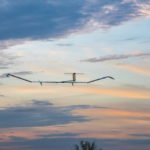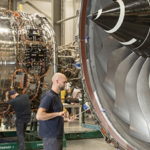The AI astronaut assistant, CIMON (Crew Interactive Mobile Companion), developed and built by Airbus on behalf of the German Aerospace Center (DLR), has passed its first tests in space, Airbus says.
The bot worked together with German ESA astronaut, Alexander Gerst, in the Columbus module of the International Space Station (ISS) for around 90 minutes.
Gerst has been living and working on the ISS since 8 June 2018. His current horizons mission, lasting six months, includes conducting a series of tests with CIMON.
CIMON is a medicine-ball-sized plastic sphere, which weighs five kilogrammes. It was created using 3D printing and is the first AI-based astronaut assistant – an experimental technology studying human-machine interaction in space.
CIMON says
On 15 November 2018 Alexander Gerst ‘met’ his artificial roommate, activating it for the very first time.
CIMON’s autonomous navigation was then tested. It performed several turns and movements in every direction and was able to search for Gerst’s face and make ‘eye’ contact.
As a demonstration of its assistance capabilities, CIMON displayed instructions for a school science experiment on crystallisation and a video of the Rubik’s cube puzzle on its ‘face’, a screen set in the centre of the sphere. It also played a piece of music.
CIMON’s ultrasonic sensors were then tested. They have a similar function to a car’s parking sensors. CIMON took a photo and shot a video of Gerst using its integrated cameras.
Till Eisenberg, CIMON Project Manager at Airbus, said: “CIMON represents the realisation of an Airbus vision. It is a huge step forward for human space flight, achieved by working in cooperation with our partners. With CIMON, we have laid the foundations for social assistance systems that are designed to be used under extreme conditions.”
“Aerospace history”
Dr Christian Karrasch, CIMON Project Manager at the DLR Space Agency, added: “It is an incredible feeling and absolutely fantastic to be able to experience CIMON actually seeing, hearing, understanding and speaking. This first, real deployment in space has made aerospace history, and marks the start of what will hopefully be a long deployment on the ISS.”
He added: “I am fascinated by interactions with artificial intelligence. The CIMON system is the only one of its kind, and was designed specifically for deployment on the International Space Station. We are entering uncharted territory and pushing the boundaries of technological expertise in Germany.”
How CIMON works
CIMON uses the Wi-Fi on the ISS to transmit data, making use of satellite connections to ground stations to establish an internet connection with the IBM Cloud.
Matthias Biniok, IBM project lead, explained the processes that then take place in CIMON’s ‘brain’: “If CIMON is asked a question or addressed, the Watson AI firstly converts this audio signal into text, which is understood, or interpreted, by the AI. IBM Watson not only understands content in context, it can also understand the intention behind it. The result is a tailored answer, which is converted into speech and then sent back to the ISS, enabling a natural, dynamic spoken dialogue.”

